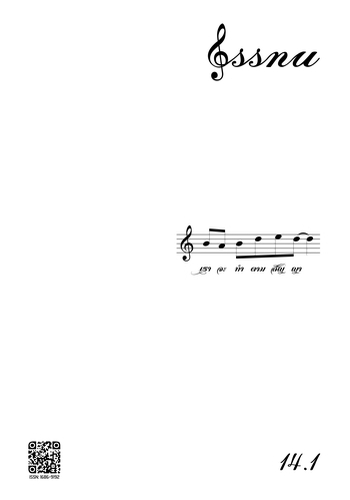The Lotus-Bud Style Chedi at Wat Chedi Yod Thong, Phitsanulok Province: An Art Evidence of the Sukhothai Period
Main Article Content
Abstract
This article aims to study the artistic style and the dating of the lotus-bud style chedi at Wat Chedi Yod Thong in Phisanulok Province. By using the art history research methodology to analyze the ground plan, style of chedi and its relations to defining characteristics of other lotus-bud style chedies during the Sukhothai period, this paper argues that the artistic style of the chedi at Wat Chedi Yod Thong reflects the strong influence of the lotus-bud style chedi at Wat Chedi Chet Theo, Sri Satchanalai, Sukhothai province and the ground plan of Wat Chedi Yod Thong having chedi at the center together with the vihara or shrine hall and surrounded by water which designated the sacred area of the temple demonstrates the popular style of ground plan of the Sukhothai period. All of these seem to suggest that the dating of the lotus-bud style chedi at Wat Chedi Yod Thong should be around early 15th century A.D. before the Ayutthaya kingdom extended both political power and artistic influence on Phitsanulok.
Downloads
Article Details
References
Royal Collection and Art of Thailand: Rattanakosin Bicentennial. (1982). Japan : Mitsukoshi.
เอกสารภาษาไทย
คณะกรรมการอำนวยการจัดงานเฉลิมพระเกียรติ พระบาทสมเด็จพระจอมเกล้าเจ้าอยู่หัว. (2548). ประชุมจารึกภาคที่ ๘ จารึกสุโขทัย. กรุงเทพฯ: กรมศิลปากร.
คทา จันทลักขณา. (2545). การศึกษาเจดีย์พุ่มข้าวบิณฑ์ในสมัยสุโขทัย. (วิทยานิพนธ์ปริญญาศิลปศาสตรมหาบัณฑิต). มหาวิทยาลัยศิลปากร. คณะสถาปัตยกรรมศาสตร์. สาขาวิชาประวัติศาสตร์สถาปัตยกรรม.
ชาญคณิต อาวรณ์. (2552). เจดีย์วัดล่ามช้างร้างในวัดพระแก้วดอนเต้าฯ นครลำปาง: ข้อสันนิษฐานรูปแบบเจดีย์ยอดทรงดอกบัวตูม. นิตยสารศิลปากร, 52: 48-57.
ตรี อมาตยกุล. (2501). จังหวัดตาก. กรุงเทพฯ: กรมศิลปากร.
ธีระวัฒน์ แสนคำ. (2554). เมืองพิษณุโลก : ประวัติศาสตร์ท้องถิ่นของหัวเมืองใหญ่ภายใต้โครงสร้างอำนาจรัฐแบบจารีต. (วิทยานิพนธ์ปริญญาศิลปศาสตร มหาบัณฑิต). มหาวิทยาลัยเชียงใหม่. บัณฑิตวิทยาลัย. สาขาวิชาประวัติศาสตร์.
รุ่งโรจน์ ธรรมรุ่งเรือง. (2545). ภาพปูนปั้นเล่าเรื่องพุทธประวัติที่วัดพระศรีรัตนมหาธาตุเชลียง. เมืองโบราณ, 28: 65-70.
ศักดิ์ชัย สายสิงห์. (2551). ศิลปะสุโขทัย: บทวิเคราะห์หลักฐานโบราณคดี จารึกและศิลปกรรม (พิมพ์ครั้งที่ 2). กรุงเทพฯ: คณะโบราณคดี มหาวิทยาลัยศิลปากร.
ศิลปากร, กรม, สำนักงานโบราณคดีและพิพิธภัณฑสถานแห่งชาติ. (2543). แผนแม่บทเมืองพิษณุโลก. กรุงเทพฯ: กรมศิลปากร.
สันติ เล็กสุขุม. (2534). เจดีย์สมัยสุโขทัย ที่วัดเจดีย์เจ็ดแถว. กรุงเทพฯ: เมืองโบราณ.
สันติ เล็กสุขุม. (2552). เจดีย์ ความเป็นมาและคำศัพท์เรียกองค์ประกอบเจดีย์ในประเทศไทย (พิมพ์ครั้งที่ 5). กรุงเทพฯ: มติชน.
สันติ เล็กสุขุม. (2555). ศิลปะสุโขทัย (พิมพ์ครั้งที่ 3). กรุงเทพฯ: เมืองโบราณ.
หวน พินธุพันธ์. (2514). พิษณุโลกของเรา. พิษณุโลก: วิทยาลัยวิชาการศึกษา พิษณุโลก.
ห้างหุ้นส่วนจำกัดดับเบิ้ลยู เอ อาร์ คอนสตรัคชั่น. (2554). รายงานการบูรณะเสริมความมั่นคงโบราณสถานวัดเจดีย์กลางทุ่ง ตำบลนครชุม อำเภอเมือง จังหวัดกำแพงเพชร. เสนออุทยานประวัติศาสตร์กำแพงเพชร สำนักศิลปากรที่ 6 สุโขทัย กรมศิลปากร.
แผนผังวัดเจดีย์ยอดทอง อำเภอเมือง พิษณุโลก. สืบค้นเมื่อวันที่ 15 มกราคม 2556จาก https://www.gis.finearts.go.th/fad50/fad/display_data6.aspx?id=0004623
ศักดิ์ชัย สายสิงห์. ศาสตราจารย์ ภาควิชาประวัติศาสตร์ศิลปะ คณะโบราณคดี มหาวิทยาลัยศิลปากร. (ตุลาคม 2556). สัมภาษณ์.
Translated Thai References
Amatayakul, T (1958). Tak Province. Bangkok: Department of Fine Arts.
Arvorn, C. (2009). Chedi at the Abandoned Wat Lam Chang in the Wat Phra Kaew Don Tao, Lampang: An Assumption of the Lotus-Bud Style Chedi. SILPAKORN JOURNAL, 52: 48-57.
Chantalakhana, G. (2002). The Lotus Bud Stupa in Sukhothai Period. Master’s Thesis, Department of Architecture and Related Arts, Silpakorn University.
Fine Arts, Department. (2005) . Corpus of Sukhothai Inscriptions. Bangkok: Department of Fine Arts.
Fine Arts, Department, Office of Archaeology and National Museum (2000). Master Plan of Phitsanulok City. Bangkok: The Fine Arts Department.
Griswold, A. B. (1967). Towards a History of Sukhodaya Art. In Leksukhum, S. Chedi during Sukhothai Period at Wat Chedi Ched Tiao. (p, 33). Bangkok: Muang Boran.
Ground Plan of the Wat Chedi Yod Thong, Muang Phitsanulok. Retrieved January 15, 2013 from https://www.gis.finearts.go.th/fad50/fad/display_data6.aspx?id=0004623
Leksukhum, S. (1991). Chedi during Sukhothai Period at Wat Chedi Ched Tiao. Bangkok: Muang Boran.
Leksukhum, S. (2009). Background and Technical Terms of Chedi Elements in Thailand. (5th ed.). Bangkok: Matichon.
Leksukhum, S. (2012). Sukhothai Art. (3rd ed). Bangkok: Muang Boran.
Phinthuphan, H. (1971). Our Phitsanulok. Phitsanulok: Phitsanulok College of Education.
Saisingha, S. Professor of Art History, Silpakorn Universitry. (2013, October). Interview.
Saisingha, S. (2008). Sukhothai Arts: Analyzing Archaeological, Artistic and Epigraphic Evidences. 2nd edition. Bangkok: Department of Art History, Faculty of Archaeology, Silpakorn University.
Sankom, T. (2011). Mueang Phisanulok : Local History of a Major City Under the Traditional State Power Structure. Master’s Thesis, Department of History, Chiangmai University.
Thamrungraeng, R. (2002). The Stuccowork Depict the Lord Buddha’s Life at Wat Phra Sri Ratana Mahathat Chaliang. Muang Boran Journal, 28, 65-70.
W.A.R Construction Limited Partnership. (2011). Report on the Restoration of the Ancient Remains of Wat Chedi Klang Thung, Nakhon Chum, Muang, Kamphaengphet. Proposed to Kamphaeng Phet Historical Park. The 6th Regional Office of Fine Arts, Sukhothai.

